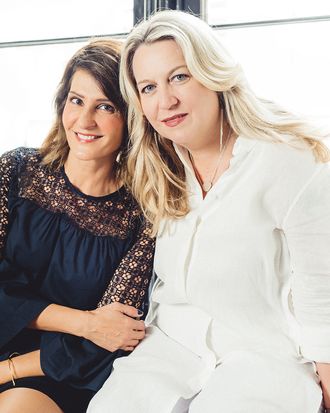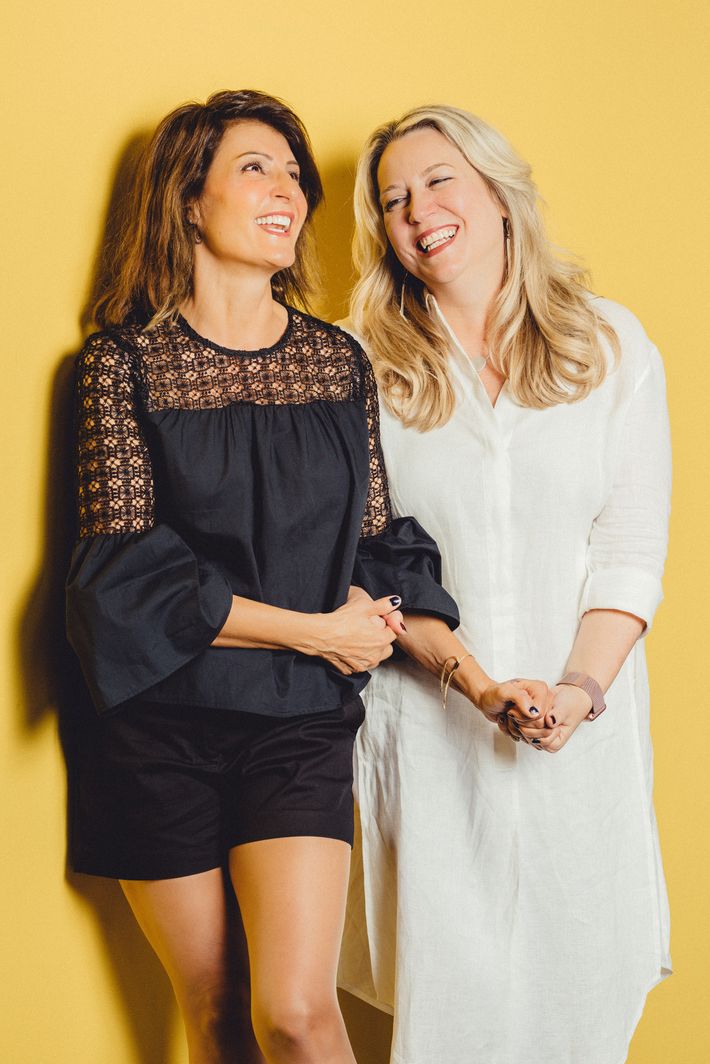
At the first preview of the Public Theater’s encore staging of Tiny Beautiful Things, Cheryl Strayed sat in the audience watching herself reveal some of her most personal experiences onstage. The Cheryl onstage is played by Nia Vardalos, who adapted the series of advice columns collected in Strayed’s book Tiny Beautiful Things, into a play. Or rather, it’s better to say that Vardalos is playing Sugar, the persona behind those columns, an unconventional advice-giver who offered up a view of her own wounds — memories of lost family members, addiction, and sexual abuse — and the lessons she learned as they healed.
Strayed wrote those columns years ago, and by then she had made peace with much of what she described. Watching herself, Strayed says, she feels vulnerable yet again. “When you perform it,” Strayed tells Vardalos as the two sit at the Public Theater’s café the day after that first preview, “you’re making it alive again, and it brings up a real mix of things inside of me, and the feeling of what’s happening to other people in the room.”
Strayed and Vardalos hadn’t met before Tiny Beautiful Things, but they developed a close kinship during the play’s production and its first run at the Public’s 99-seat Shiva Theatre last winter — this fall the play moved to the larger Newman Theater, opening October 2, with a run that was recently extended through December 10. Both women hail from the middle of North America, both write through the night, and after years of toil, both suddenly, unexpectedly found themselves famous for work sheared from their personal experience — Vardalos with My Big Fat Greek Wedding; Strayed with the one-two-three punch of Wild and Dear Sugar, which became Tiny Beautiful Things. Vulture sat down with Vardalos and Strayed to talk about surprising audience members with raw emotion, what it’s like to see your life adapted in two different ways, and Dear Sugar’s advice that is worth revisiting.
Let’s start at the beginning of the play’s history: It was Marshall Heyman who recommended the book to the play’s director, Thomas Kail, who recommended to Nia, and to the Public’s artistic director, Oskar Eustis.
Nia Vardalos: Tommy gave me the book saying, “I think this is a play.” I flew back to L.A. reading it on the plane and embarrassed myself with gasps, sobs, and hard laughs. When I landed, I said, “We have to get the rights to this book.” Several calls to agents went unanswered, we didn’t know what was happening, so I reached out to Cheryl on social media.
Cheryl Strayed: Tommy had originally sent me an email several months before, but he emailed me right in the middle of a very busy time in my life. Wild and Tiny Beautiful Things were published months apart, and I was in this weird situation where I was promoting two books at once. I dragged his email into my “to-do” file, which is like shoving it into a closet or under the bed. But one day on Facebook, I posted something and Nia commented. What caught my attention was all of these other people who were like, “Oh my god, that’s Nia Vardalos! She’s writing to Cheryl!”
NV: I said I was going to send her a DM on Twitter because I don’t understand Facebook. Then I just laid it out, as if I was writing a letter to Sugar: “Dear Cheryl, Tommy Kail gave me this book, we are hoping to make it into a play.” Cheryl said, “I’m coming to L.A. tomorrow to see the first screening of Wild.”
CS: After Jean-Marc Vallée had finished the first cut of Wild, and I went and saw it with him and Reese and Laura Dern and my husband, the next day my husband and I met Nia for tea in the hotel in Santa Monica.
NV: The emotions that carry you into a place of grieving and reconciling the pain that you didn’t know you had permission to feel anymore was what made me feel this could carry a narrative. But talking to you was what made me realize, Oh, we have so much in common. When Tommy and I got to know you, we learned that you wrote in your kitchen, which informed our choices. Your house, your children, your relationship with Mr. Sugar. Cheryl was an open, open, open book. There were no questions left unanswered.
Cheryl, you wrote Dear Sugar after you had written Wild, but before the book came out. What was your life like then?
CS: Tiny Beautiful Things is really the book I wrote by accident. I sold Wild, wrote it, finished the whole draft, sent it to my editor, and days after I had sent it off, [the Rumpus editor] Steve Almond emailed me and asked if I wanted to take over this column. I thought, “Oh, I’ll just do this little thing for the fun of it, on the side, while I’m doing the edits of Wild.” I did revisions, but then they held [Wild] for a year, so I was sort of drumming my fingers, waiting for the book to come out.
Meanwhile, Sugar was becoming more important to me as a writer. All these editors were emailing Sugar, saying, “I don’t know who you are, but if you want to publish a book, just give me a call.” Meanwhile, I’ve got this other book! I went to my publisher and said, “We need to publish a book of the Dear Sugar columns, let’s just do it now,” and then that went into the pipeline!
NV: The one thing that really struck me is how you were a paid author, and yet you were writing this for free. It was feeding something, and you were feeding so many people. You had this memoir coming out and yet you’d write at night, all week.
CS: I think there can be this overly idealized idea of, “Real artists don’t get paid,” which is why we’ve been screwed over for all time. I hate that and I’m very adamantly against that, but I also know that sometimes you do things only because you want to. I did Sugar because I wanted to.
Both of you have had the experience of getting very famous very quickly from your very personal work — with Tiny Beautiful Things and My Big Fat Greek Wedding. What is that like?
CS: It’s everything! By that I mean it’s a wide range of things. It’s wonderful, terrible, true. There is a way in which it is true that people know a lot about me if they’ve read my work, and there’s another way in which you don’t know me at all. One of the things I write about as Sugar so much is that the journey is about learning how to set boundaries, when to say yes or no, and how to be brave in your conversations with people.
NV: When the movie [My Big Fat Greek Wedding] came out, I was satisfied with that. I’m a middle child …
CS: Like me!
NV: I don’t have an overarching goal when I write something. It’s just, “That’s it.” Then what happened was shocking, and I was so grateful for it, because all doors opened to me and I got to create other work and mentor other people and find projects that were definitely never going to get made unless I said, “I’d like to try this.” What I really, ultimately have come to terms with is that the “me” I grew up being, a little bit, no, a lot socially awkward, now, I realize there’s only one you, so embrace that person. Embrace that inner geek. Cheryl and I are from sister cities, we’re prairie girls …
CS: … you’re northern Minnesota and I’m Winnipeg.
NV: We are two people who said, “Why not me?” and we started to write.

Cheryl, what has it been like to see yourself played in two different roles so quickly in succession, in Wild with Reese Witherspoon, and now with Nia in Tiny Beautiful Things?
CS: The most surreal experience of my life, and I’m not being hyperbolic. Whenever Nia, onstage, says, “I’m Cheryl Strayed,” I have, like, a visceral reaction to it. There’s this wonderful way in which it’s a very intimate moment, watching them be me, and it’s also a very expansive moment, where I realize that none of this is me. It’s all what I put in the world.
NV: Very early on, Tommy Kail decided I would not be doing an imitation of you, but that we wanted to create a role.
CS: Reese did try to be me. She tried to look like me, looked at photographs of what I wore, they asked me what my house looked like. But Nia has done a very different thing. Even though Sugar is me, there’s also no question that Sugar’s a version of myself that was actually the conduit for this exchange done in the dark. I think Nia was really perceptive to pick up on that dynamic, that she was both Cheryl Strayed and, I guess, the force of this connection between these two people.
NV: What I was hoping to do with this role was create a role that could be played by a multitude of women. Think of the age range of the women who could play this role, and the ethnicities. This is what we were hoping to do.
How did you decide which questions to include in the show?
NV: It was really hard to decide which pieces could go on to the train tracks of the play, and which pieces were boxcars that we had to cut loose. The first reading, two-and-a-half to three years ago, was vastly different than this. I’m still writing. I went home last night after the first preview and will change a few things with Tommy’s permission.
CS: What’s often said about writers is that you have to kill your darlings, and the agony of being adapted is that somebody else kills them!
NV: I couldn’t believe how magnanimous you were about it. I thought at some point, you’d say “sure,” and then I’d walk to the door and you’d leap and send me into the ground.
What is it about good advice that is something you can revisit? Many of the people coming to the show have read Dear Sugar’s columns before — what draws them back?
CS: What I always wanted to do more was illumination rather than instruction, and I don’t think there’s anything wrong with instruction. There are times when, embedded in one of the columns, I say, “I think you should do this.” That’s the traditional style of an advice column. But what I was really trying to do as a writer was something else, which was illuminate the question in a way that deepens it, allows the reader to think about the questions that weren’t asked. I don’t know that I was conscious of that. I talk about it as if it was my grand plan, but when I look back I realize what I was trying to do in the columns.
NV: We would often ask, when she got letters, would she answer them right away? And I love what you said: You walked around them.
CS: When something landed with me and I couldn’t get it out of my mind, I’d walk around and I wouldn’t be writing. I’d be with my kids, pushing them on the swing in the park, and this person — their suffering, their secret, their sorrow — would be coming to me, and through me. A story would rise up in me, an experience I had in my own life, that seemed, oftentimes, completely unrelated to the letter or question, and I would think, “I have to start writing that story and trust that there’s a thread between me and you.” Sometimes there wasn’t and I failed, but a lot of times there was.
NV: I love that. I think that also informs the choice [in the play’s staging] of the letter writers coming into the house. They stay with Sugar until they get what they need.
There’s one seemingly nonsense reader question: “WTF.” It gets repeated throughout the play until Sugar answers with this anecdote about her own abuse. Was that something you had to sit with for a long time?
CS: In real life it was the opposite experience. In the play, she’s like, “Of course I’m going to not answer this question because it’s not a question,” and then she’s finally ready for it. In real life, I was sitting at my computer as soon as that question came in, so I saw it come in, I read it, and I almost immediately deleted it, because it’s not a letter, you know? I stopped — and I started writing. That was one I didn’t think about. I immediately wrote the response, and the next day it was on the website.
I was terrified, because I’m writing about being sexually abused. It’s the part of the play I have to muscle my way through as an audience member — I always sink in my seat. I’m sometimes crushed by it. I hate that part of the play, even though I think it’s a necessary part. I realized last night it was because I knew there were a whole bunch of people in the room who have had this experience, and I feel that sorrow. I was so aware last night that there were people in the room who experienced sexual abuse as children, and they have to sit there and feel what they’re feeling. I think that is a good thing, a powerful thing, but it’s hard.
NV: They’ve come to me in the lobby. They’re so familiar with the book. My favorite duo of audience members are someone who’s read the book and someone who hasn’t. But the people who have read the book have told me, “I am … *insert name here*.”
CS: When you’re up there, are you thinking about that ever? How do you not let that feeling of other people’s emotional experiences, in the room, interfere with your work?
NV: Tommy’s direction really helped me. He said, “This happened to you a long time ago, you have something to tell this person.” I have processed it, and that’s what helps me.
CS: This is what’s so strange to me about my experience of it with the play — that’s true. I wrote it. I’m healed. I’m okay. I can make jokes about it. But I wrote that piece because I have processed it. Somehow, when it’s in your hands, I feel vulnerable to it, whereas when I’m the writer, I’m in command. But when you perform it, you’re making it alive again, and it brings up a real mix of things inside of me.
NV: I had a friend sitting behind you in one of the performances in the last run, and he said he just wanted to put his arms around you and say, “Thank you for telling this story.”
CS: One of the things about that story, too, is, that some people in the room are thinking, “Thank you for telling that story.” Other people are thinking, “Who would say that stuff? This is so gross and ugly.” It makes some people very uncomfortable, to the point of being repulsed by it. People aren’t comfortable with people sharing certain things, right? Don’t you think there are people who walk into the play and think, “What the fuck am I doing here?”
NV: Absolutely. That’s a good theatrical experience.
This interview has been edited and condensed.





